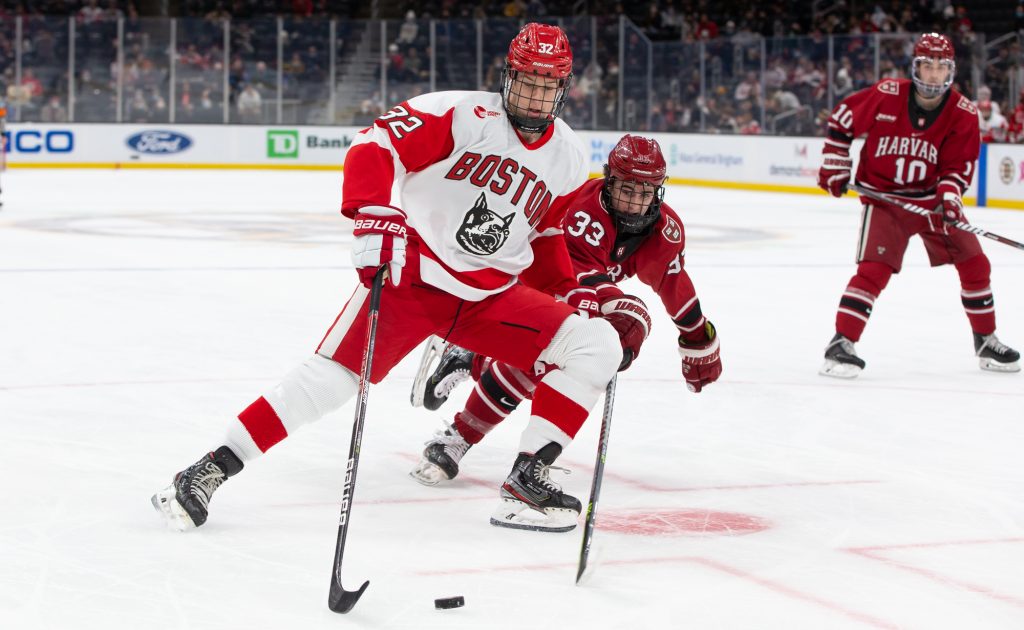
As we approach the home stretch of the college hockey season, we’re seeing some teams really solidify their NCAA tournament positions.
We can say certainly that Minnesota State, Michigan and Minnesota all have punched their NCAA tickets and Denver, North Dakota, Western Michigan Notre Dame and St. Cloud State are all virtual locks (though my computer still marks them as 99.9 percent, so that’s not 100 percent in my book).
The second bucket of teams are those who aren’t clinched but a darn close. That’s where we’ll place the 99.9 percenters and those with better than an 85 percent chance right now, which includes Massachusetts, Minnesota Duluth, Michigan Tech, and Ohio State.
Right there, you have 13 teams plus the AHA champion, which makes 14. There are a maximum of two slots remaining and plenty of teams that currently maintain hope.
Leading that list are three Hockey East teams – UMass Lowell, Boston University and Northeastern, all of which have a percentage chance a little higher than 30 percent. You can also put Clarkson, Providence and Merrimack in that mix, though each of their odds are slightly lower.
What does that mean? You have six teams hoping to fill the final two at-large slots (and that’s assuming we don’t have an upset in a conference tournament). It’s safe to say if you’re in the bubble group of six, you can’t afford any losses in the next week.
As for this week’s brackets, you’ll see that Jayson and I agree on almost everything. Read forward to see how each of us approach the seeding of the current 16 teams inside the PairWise bubble.
Jayson’s bracket and approach
Once again, this week let me start out by putting everyone into bracket integrity. That means:
1. Minnesota State
8. Quinnipiac
9. St. Cloud State
16. AIC
2. Michigan
7. Notre Dame
10. Massachusetts
15. Boston University
3. Denver
6. Western Michigan
11. Minnesota Duluth
14. UMass Lowell
4. Minnesota
5. North Dakota
12. Michigan Tech
13. Ohio State
Now I will check for intra-conference matchups. I have Western Michigan-Minnesota-Duluth and Minnesota-Ohio State.
First, we swap Ohio State and Mass-Lowell.
We have two NCHC teams in both the second and third bands. So we have to split them.
The only logical way to do it is to swap Massachusetts and Minnesota-Duluth.
Therefore, our brackets are now:
1. Minnesota State
8. Quinnipiac
9. St. Cloud State
16. AIC
2. Michigan
7. Notre Dame
11. Minnesota Duluth
15. Boston University
3. Denver
6. Western Michigan
10. Massachusetts
13. Ohio State
4. Minnesota
5. North Dakota
12. Michigan Tech
14. UMass Lowell
Now, I will start placing the brackets into regionals.
Loveland – Denver bracket because Denver is the host.
I want to place the Minnesota State bracket in Albany because of Quinnipiac and AIC.
I want to place the Michigan bracket in Allentown because Penn State is the host and there are two Big Ten schools in that bracket.
Then I am left with the Minnesota bracket in Worcester.
Albany
1. Minnesota State
2. Quinnipiac
3. St. Cloud State
4. AIC
Allentown
1. Michigan
2. Notre Dame
3. Minnesota Duluth
4. Boston University
Loveland
1. Denver
2. Western Michigan
3. Massachusetts
4. Ohio State
Worcester
1. Minnesota
2. North Dakota
3. Michigan Tech
4. UMass Lowell
That’s about the best that I can see coming out of the brackets and what we have to work with.
Jim’s bracket and approach
Believe it or not, Jayson and I have the exact same alignments of teams. My only difference in approach is to swap Jayson’s Albany bracket with his Allentown bracket.
I understand his desire to place the only ECAC participant, Quinnipiac, into the Albany Regional, which is hosted by the ECAC. But unlike when a school is the host and a team must be placed in that bracket (Denver, for example), there is no requirement to place an ECAC school in the regional that is hosted by the league.
Honestly, I feel like Quinnipiac might be the only school in the field that can come close to boosting attendance in Allentown. Is this a reason alone to place the Bobcats there? Not really. But it also keeps top seeded Minnesota State a little bit closer to home than Albany (albeit still really far away). And the fact that the NCAA considers the Allentown Regional one of the two “west” regionals, there is a chance the committee feels compelled to keep the top overall seed “west.”
Yes, it’s a crazy approach, but it’s my approach this week.
Thus, my bracket is:
Allentown
1. Minnesota State
2. Quinnipiac
3. St. Cloud State
4. AIC
Albany
1. Michigan
2. Notre Dame
3. Minnesota Duluth
4. Boston University
Loveland
1. Denver
2. Western Michigan
3. Massachusetts
4. Ohio State
Worcester
1. Minnesota
2. North Dakota
3. Michigan Tech
4. UMass Lowell
There is still plenty of time left for things to take some major shifts, but this week, that’s all I can do.


